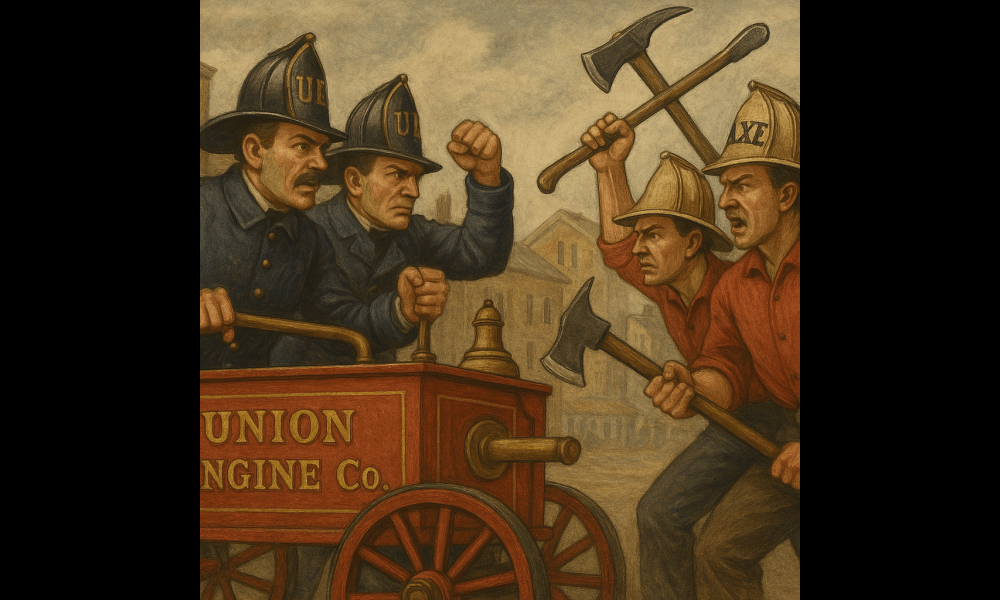The reorganization of the Halifax fire department in 1861 marked a critical turning point in the city’s fire protection history. This transformation came as a direct response to a disastrous fire on January 12, 1861, which effectively exposed the shortcomings of the existing system and ultimately led to the complete disbandment of all former fire companies.
Here are the verified details of the 1861 fire department reorganization:
Context: The January 12, 1861 Fire
-
A major fire broke out on Hollis Street, destroying several important buildings including the City Hotel, Exchange Building, Reed’s Hat Shop, George S. Campbell’s dry goods, and William Robertson’s premises.
-
The firefighting response was disorganized. Companies either refused to cooperate or were slow to respond.
-
The fire became a public scandal and ignited outrage from city residents, many of whom criticized the "jealousies and quarrels" between the Union Engine Company, Axe Fire Company, and Hook and Ladder Company.
Immediate Consequences
-
Within a week, the City Council passed a motion to disband the entire fire department as it had stood up to that point.
-
The Council issued formal notices of dissolution to all existing companies and revoked their access to the engine houses and equipment.
-
The disbandment included:
-
Union Engine Company (est. 1783)
-
Axe Fire Company (est. 1812)
-
Hook and Ladder Company
-
Reorganization (Spring 1861)
By spring of that year, the city began to rebuild its firefighting structure from the ground up:
-
Volunteer Engine Company
-
Created to replace the Union Engine Company.
-
Comprised of some former members of the disbanded companies, but now operated under tighter municipal control.
-
-
Volunteer Axe Company
-
Replaced the old Axe Fire Company.
-
Took over its equipment and responsibilities, but with reorganized leadership.
-
-
Union Protection Company
-
This was a newly named company and should not be confused with the original Union Engine Company.
-
Its creation was a symbolic gesture as much as practical—it represented a clean break from the old factions.
-
Administrative Reforms
-
All equipment was reassigned.
-
Engine houses were reorganized and newly staffed.
-
City Council took a stronger supervisory role, ending the era of independently run companies.
-
Leadership structures were reset, and a new culture of collaboration and discipline was emphasized.
Significance
The 1861 reorganization:
-
Ended nearly 80 years of quasi-independent firefighting companies.
-
Marked the beginning of the “New Fire Companies Era”, which extended until 1894.
-
Laid the foundation for more centralized fire governance, leading eventually to the fully municipal Halifax Fire Department in 1896.
Newly Formed Fire Companies (1861)
After the January 12, 1861 fire and the complete disbandment of the original companies, three entirely new volunteer fire companies were established under tighter municipal oversight:
Volunteer Engine Company (1861–1894)
-
Role: Operated the city's main fire engines and hoses.
-
Composition: Many members were recruited from the former Union Engine Company, but they now operated as part of a unified, city-controlled structure.
-
Notable Details: While its personnel shared continuity with the Union Engine Company, this new unit was considered legally and organizationally distinct.
-
Engine House: Initially based out of the same or repurposed facilities formerly occupied by the Union Company.
-
Volunteer Axe Company (1861–1896)
-
Role: Carried and operated axes, ladders, hooks, and other tools; responsible for forcible entry, ventilation, and rescue.
-
Composition: Recruited primarily from the disbanded Axe Fire Company, but reorganized under new leadership.
-
Distinctive Duties: Continued the tradition of dragging their own carts containing ladders and hooks to fires.
-
Uniform: Retained aspects of their distinctive dress and identity, but operated with clearer accountability to the city.
-
Union Protection Company (1861–1919)
-
Role: A new name with a dual purpose—firefighting and fire prevention.
-
Symbolism: Though the name referenced the former "Union" company, this was a completely new organization, created to distance the department from the former divisions and rivalries.
-
Formation: Deliberately chosen to break with the legacy of the Union Engine Company.
-
Mandate: Emphasized discipline, efficiency, and cooperation between companies.
-
Redistribution of Equipment
When the fire department was dissolved in 1861, all engines, hose reels, ladders, and other apparatus were confiscated and inventoried by the city. Equipment was then redistributed to the newly created companies:
Equipment Allocation
-
Former Union Engine Company engines (six total, one unreliable) were reassigned primarily to the Volunteer Engine Company.
-
Hose reels and hose (4,000 feet good, 500 feet fair) were also transferred to the Volunteer Engine Company, but now with centralized storage locations and revised maintenance oversight.
-
Ladders, hooks, and specialized tools used by the Axe Fire Company were reassigned to the Volunteer Axe Company.
-
One ladder cart and possibly other salvaged equipment (from the defunct Hook & Ladder Company) were given to the Union Protection Company, which absorbed certain logistics functions.
-
Engine Houses
-
Existing engine houses were retained but reassigned:
-
The Argyle Street Engine House (built 1837) and the Argyle Axe and Ladder Co House (built 1856) continued in use.
-
Other smaller houses, like those at Spring Garden Road, St. George’s Church Grounds, and Bridewell, were either reallocated or decommissioned depending on condition and location.
-


